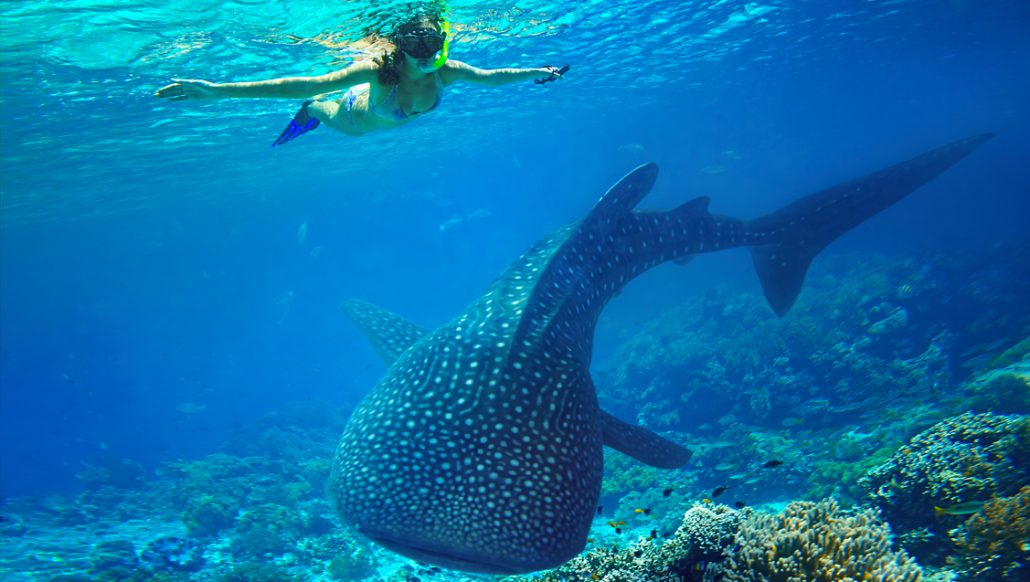Summer is Whale Shark Season in the Mexican Caribbean. If you are traveling to Cancun or Riviera Maya soon and love the underwater world, how about your own once-in-a-lifetime encounter with nature, an unforgettable swim with the whale sharks. You’ll have seen these gentle giants in nature programs filmed by the BBC and National Geographic but have you ever imagined coming face to face with one? All through the summer until mid-September in the Mexican Caribbean, you have the opportunity to swim with the whale sharks, world’s largest fish.
Whale sharks, one of the ocean’s great travelers
Whale sharks are great ocean wanderers, traveling thousands of miles through the tropics in search of the microscopic plankton that is their staple diet. From mid May to mid September, they gather in the Mexican Caribbean where higher temperatures mean an abundance of plankton. Hundreds of whale sharks feast on plankton in the waters off the islands of Holbox, Contoy and Isla Mujeres. Biologists believe that this is the largest whale shark gathering or aggregation in the world and that it isn’t only plankton that attracts them, but also fish roe. It is the spawning season of a fish called the little tunny (bonito) and researchers have discovered that the whale sharks are partial to the eggs.
There are actually two whale shark feeding grounds: the area between the island of Holbox and Cabo Catoche and “blue water,” a stretch of deeper water to the east of Contoy and Isla Mujeres, a two-and-a-half-hour boat ride from Cancun. Due to the importance of this area for whale sharks and other marine species such as sailfish, marlin, manta rays, dolphins and sea turtles, the Mexican government declared part of the zone a marine biosphere reserve.
Imagine snorkeling alongside a whale shark and watching as a creature the size of a bus looms out of the depths, approaches you and then swims placidly by, its gaping jaws open to scoop up the plankton. With a final flick of the tail it disappears into the distance, leaving you with with an incredible sensation of happiness and peace. It is an awe-inspiring sight and an emotional experience, one that wildlife watchers shouldn’t miss.
The domino fish
Whale sharks are also known as “domino fish” due to their distinctive stripes and dappled markings. Each fish has its own unique pattern and taking photos of them is helping whale shark experts around the world to compile a catalog. Through the use of this international database for identification purposes and by tagging sharks they can now begin to map the movements of these enigmatic creatures during the year.
In addition to the Atlantic Ocean, the Caribbean and the Gulf of Mexico, whale sharks are also found in the Indian and Pacific Oceans and gather around Ningaloo Reef in Western Australia, Fiji, the Seychelle Islands, South Africa, Mozambique, Tanzania, Madagascar, the Gulf of Oman, India, Indonesia and the Philippines. In the Americas, they are also found in the Sea of Cortez in Baja California, Mexico, Belize, the Bay islands of Honduras and off the coast of Brazil. Whale sharks are also known to range as far south as the remote island of St. Helena in the southern Atlantic.
Whale sharks are now on the endangered list due to overfishing in some parts of the world, boat strikes and ocean pollution.In Mexico they are a protected species.
Planning a Whale shark trip
Guided small group eco trips to see the whale sharks are available from Cancun, Isla Mujeres and Holbox. During the boat trip out to the whale shark feeding grounds, your guide will explain the whale shark rules.
Whale shark trip rules
• Keeping your distance (five meters) from the whale sharks
• Do not attempt to touch whale sharks
• Swim alongside whale sharks, do not swim in front of them
• Only two people per boat plus a guide are allowed in the water at one time
• The use of sun products and flash photography are not permitted
On the journey out to the whale shark area, you may spot wild dolphins and sea turtles. Huge manta rays also gather to eat plankton and sometimes breach the water surface in spectacular flight.
Another option for an unforgettable whale shark adventure is to plan an overnight trip to Holbox, the beautiful island on the north coast of Quintana Roo. Here even the wooden signs lining the sandy streets show the famous pez domino, as the whale shark is affectionately called by local fishermen. Go in search of whale sharks early in the morning. Take another boat trip to explore the Yalahau Lagoon, Isla de los Pajaros (Bird Island) and the Yalahau Cenote in the afternoon and you’ll still have time for the beach and to discover the rustic laidback ambiance of the island.
Isla Mujeres hosts an annual Whale Shark Festival during the summer, check this blog for the 2016 dates later in the season.

